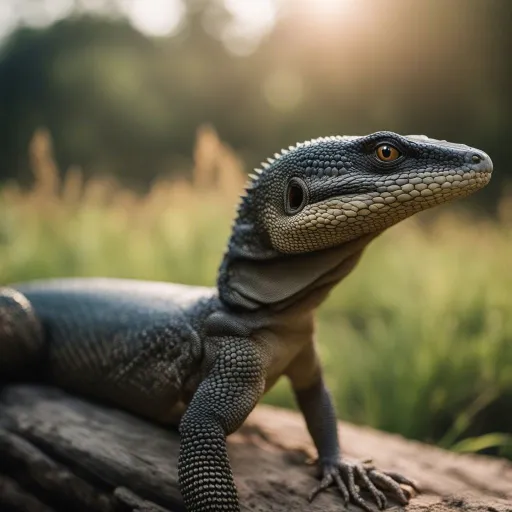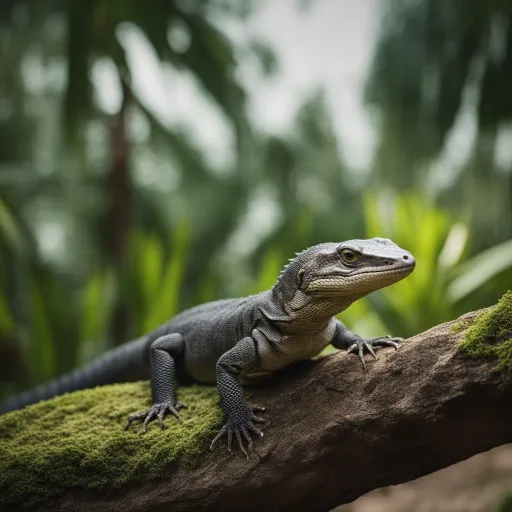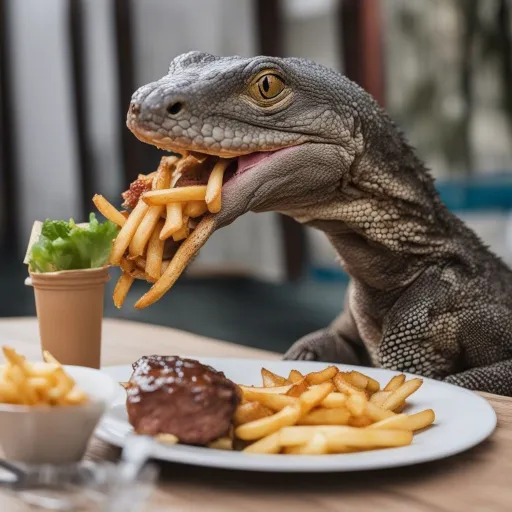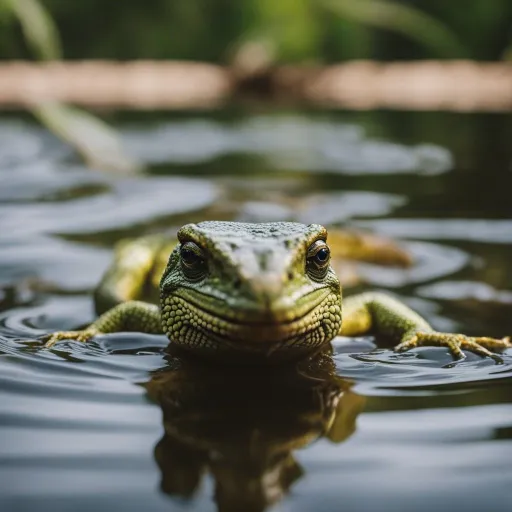
So, you’re curious about the eating habits of monitor lizards, huh? Well, you’re in for a treat! In this article, we’re going to explore the fascinating world of these magnificent reptiles and discover what satisfies their hunger.
From the smallest insects to large mammals, a monitor lizard’s diet is diverse and truly impressive.
Get ready to be amazed as we uncover the secrets of what makes these creatures some of the most formidable predators in their habitat.
General Overview
Monitor lizards, also known as varanids, are a fascinating group of reptiles that belong to the family Varanidae.
With their striking appearances and unique behaviors, these reptiles have captured the curiosity of both scientists and reptile enthusiasts alike.
One of the key aspects that has captivated researchers is the dietary classification of monitor lizards.
Known for their varied feeding habits, monitor lizards can be classified as omnivorous or carnivorous, depending on the species and their individual preferences.
This article will explore the dietary classification of monitor lizards and delve into the fascinating world of their feeding behaviors.
Dietary Classification of Monitor Lizards
Omnivorous Diet
Some monitor lizard species, such as the Asian water monitor (Varanus salvator) and the Nile monitor (Varanus niloticus), have an omnivorous diet.
This means that they consume a mixture of plant matter and animal prey. Their plant-based diet consists of a variety of fruits, vegetables, and other plant material.
These opportunistic feeders will readily consume fallen fruits, leaves, and flowers. Additionally, they may actively seek out and consume specific plant species that provide essential nutrients.
Carnivorous Diet
On the other hand, several monitor lizard species have a predominantly carnivorous diet.
These reptiles primarily feed on animal prey, seeking out a wide range of creatures in their natural habitats.
This carnivorous diet allows them to obtain the necessary nutrients and energy to survive.
Their hunting abilities and dietary preferences enable them to fulfill their dietary needs effectively.
Native Prey
Monitor lizards have adapted to their environments and have evolved to feed on a variety of prey species. These preys can be categorized into various categories:
Small Mammals
Small mammals are a common food source for monitor lizards. This category includes rodents, such as mice and rats, as well as small marsupials and other insectivorous mammals. Monitor lizards use their keen sense of smell and stealthy hunting techniques to locate and capture these elusive creatures.
Birds and Eggs
Birds and their eggs are another important food source for monitor lizards. These reptiles have been observed scavenging bird nests to feed on both eggs and nestlings. Some monitor lizards are skilled climbers, enabling them to access bird nests that are located high up in trees.
Reptiles and Amphibians
Being part of the reptile family, it’s no surprise that monitor lizards prey on other reptiles and amphibians. Snakes, lizards, and even other monitor lizards become victims of their predatory instincts. Some species, like the Komodo dragon (Varanus komodoensis), are known to have an appetite for their own kind.
Insects and Arachnids
Insects and arachnids form an essential part of a monitor lizard’s diet. These creatures provide a readily available source of protein and are often found in abundance in their habitats. Termites, beetles, and spiders are just a few examples of the invertebrates that monitor lizards prey upon.
Fish
Monitor lizards are excellent swimmers, and their aquatic abilities enable them to target fish as a food source. Species like the water monitors are highly adept at catching fish in various aquatic habitats, including ponds, rivers, and even the ocean.
Crustaceans and Shellfish
Crustaceans and shellfish, such as crabs and snails, also make up a part of a monitor lizard’s diet. These hard-shelled creatures require the monitor lizard’s powerful jaws to crack and consume the tasty meat inside.
Opportunistic Feeding Behavior
Monitor lizards are opportunistic feeders, meaning they take advantage of available food sources in their environments. They are adaptable creatures, able to adjust their feeding behavior based on the season, location, and prey availability. This flexibility allows them to survive and thrive in various habitats, from dense forests to arid grasslands.

Foraging Techniques
To succeed in their hunt for food, monitor lizards have developed several foraging techniques that maximize their chances of catching prey. Three primary foraging techniques are as follows:
Ambush Predation
Monitor lizards, especially those with an omnivorous diet, often make use of ambush predation. They patiently lie in wait for unsuspecting prey to pass by their hiding spot. With their excellent camouflage and incredibly quick reflexes, they are able to launch surprise attacks on their victims, overpowering them with their jaws and claws.
Active Hunting
Some monitor lizards are active hunters, pursuing their prey with agility and precision. These reptiles use their superior speed and long, muscular tails to their advantage, swiftly chasing down their quarry. Active hunting is often seen in monitor lizard species that have a carnivorous diet and must actively seek out fast-moving prey.
Scavenging
Monitor lizards are not shy about scavenging for food when the opportunity presents itself. They will eagerly consume carrion, feeding on the remains of already deceased animals. This adaptive behavior allows them to make the most of available food resources, particularly during times when hunting becomes more challenging.
Diet Variations Among Monitor Lizard Species
Although monitor lizards share certain dietary preferences and foraging techniques, it’s important to recognize that there can be significant variations in their diets among different species. Factors such as habitat, geographic location, and even individual behavioral characteristics can influence the specific foods consumed by each species.
For example, the Komodo dragon, which populates the islands of Komodo, Rinca, Flores, and Gili Motang in Indonesia, is the largest living lizard species and relies heavily on large ungulates for food. In contrast, the black-throated monitor (Varanus albigularis ionidesi), which is found in southern Africa, feeds primarily on invertebrates and small reptiles.
Influence of Habitat on Diet
The habitat in which a monitor lizard resides has a significant influence on its diet. For example, monitor lizards found in tropical rainforests have a more diverse diet compared to those living in drier, arid regions. This diversity is due to the higher availability of various food sources in a rainforest ecosystem, including fruits, insects, and small mammals.
Similarly, monitor lizards dwelling in aquatic habitats will have a diet that is heavily skewed towards fish, crustaceans, and other water-dwelling prey. These reptiles have developed specialized adaptations that enable them to excel in their respective habitats and secure the necessary sustenance to survive.

Feeding Adaptations
Monitor lizards possess several remarkable adaptations that aid them in their pursuit of food. These adaptations have evolved over millions of years, equipping them with the necessary tools to catch and consume their prey effectively. Some of the notable feeding adaptations are described below:
Powerful Jaws and Teeth
Monitor lizards have incredibly powerful jaws and sharp teeth that enable them to capture, immobilize, and consume their prey. Their jaws are highly muscular and capable of delivering formidable bites. The sharp and serrated teeth efficiently tear through flesh and hold struggling prey, allowing the monitor lizards to maintain a firm grip during the struggle.
Venom
Certain monitor lizard species, such as the Komodo dragon, possess venom glands in their lower jaws. While the exact nature and function of this venom are still under scientific investigation, it is believed to aid in taking down prey more effectively. The venom may contain a cocktail of toxins that causes prey to experience reduced blood pressure, paralysis, and increased blood loss.
Forked Tongue
Monitor lizards have a forked tongue, which plays a crucial role in detecting prey. By flicking their tongues in and out, they pick up scent particles from the environment. These particles are then brought back to two specialized organs located on the roof of their mouths called Jacobson’s organs. This extraordinary sense of smell helps monitor lizards locate potential prey, even from a considerable distance.
Acidic Stomach
Monitor lizards possess a highly acidic stomach that aids in the digestion of both plant matter and animal prey. The strong stomach acid breaks down proteins and facilitates efficient absorption of vital nutrients. This adaptation allows monitor lizards to extract maximum nutrition from their varied diet.
Adaptive Digestive System
Monitor lizards have digestive systems that are adapted to handle different types of food. Their intestines possess unique enzymes that aid in breaking down plant material or animal proteins, depending on the specific dietary requirements of each individual species. This flexibility allows monitor lizards to adjust to the availability of different food sources and survive in diverse environments.
Cautions and Concerns
While monitor lizards have unique feeding habits and play a crucial role in their ecosystems, their behavior can sometimes raise concerns. Two specific areas of caution regarding monitor lizards are as follows:
Feeding on Carrion and Potential Disease Transmission
As mentioned earlier, monitor lizards are known to scavenge on carrion, including dead animals. While this behavior is an essential adaptation that enables them to survive during times of scarce prey, it can also raise concerns regarding the potential transmission of diseases. By consuming carcasses, they come into contact with pathogens that may pose health risks to both humans and other wildlife.
Impact on Local Ecosystems
Monitor lizards, particularly species introduced to non-native environments, can have a significant impact on local ecosystems. When such lizards become invasive, they may outcompete native species for food and habitat, disrupting the delicate balance of the ecosystem. Invasive monitor lizard populations can result in the decline of certain species and negatively affect biodiversity.
Human-Monitor Lizard Interaction
Human-monitor lizard interaction can vary greatly, and it is important to understand the potential risks and conservation concerns associated with these reptiles. Three key aspects of the interaction between humans and monitor lizards are as follows:
Risk of Predation on Domestic Animals
In regions where monitor lizards and domestic animals coexist, there is a potential risk of predation on livestock and pets. Monitor lizards, particularly larger species, may pose a threat to small farm animals and domestic pets if they are not adequately secured or protected. Proper management and vigilance are crucial to mitigating these risks and ensuring the safety of domestic animals.
Illegal Wildlife Trafficking
Monitor lizards, with their unique characteristics and exotic allure, are sometimes victims of illegal wildlife trafficking. These reptiles are prized for their rarity and impressive appearances, making them sought after by collectors and enthusiasts. The illegal trade in monitor lizards poses a severe threat to their conservation and survival in the wild.
Conservation Efforts
Efforts to protect and conserve monitor lizards are vital for their long-term survival. Many organizations work tirelessly to raise awareness about the importance of these reptiles in their ecosystems and implement measures to protect their habitats. Conservation projects aim to address the threats faced by monitor lizards and ensure their future generations can thrive in the wild.
Final Thoughts
In conclusion, monitor lizards are awe-inspiring creatures, with their varied diets and fascinating feeding behaviors.
These reptiles have mastered the art of survival through their adaptability and prey preferences.
Understanding their dietary classification, native prey, foraging techniques, feeding adaptations, and potential challenges is crucial in appreciating and safeguarding the diverse world of monitor lizards.
Through education, conservation, and responsible management, we can ensure the continued existence and well-being of these remarkable reptiles for generations to come.



